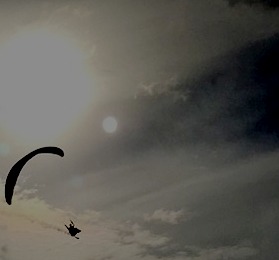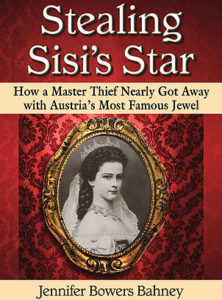
A daring jump
The night lights of Vienna swayed 12,500 feet beneath him as Gerald Blanchard perched at the airplane hatch. Once the Schönbrunn Palace came into sight, he signaled the pilot to slow down. Then Blanchard adjusted his parachute one last time. A nighttime jump to a city roof counted among the most dangerous types of skydives, but Blanchard was no ordinary thief. The theft he was about to accomplish – the Köchert Diamond heist – has taken its place among the most daring jewelry thefts ever.
The day before, he’d taken a palace tour. On display glittered Austria’s most famous jewel, the last remaining Köchert Diamond, one of the jeweled stars Empress Elisabeth used to wear in her hair. Blanchard hatched a plan to steal it.
An expert at analyzing weaknesses in security systems, Blanchard lingered behind the tour group, videotaping the room and making preliminary preparations. From the roof, he decided. Whoever planned the palace security system didn’t take that method of entry into account.
Blanchard then contacted a friend of his, a German pilot, to fly him over the city that night for the jump. Once inside the palace, he dismantled the display case and switched out the diamond with a replica he’d purchased in the museum shop.
A crime that touched history
He may not have known it, but as his hand touched the diamond, Blanchard’s 1998 crime converged with one of Europe’s greatest 19th-century crimes. The only woman to ever have worn that star, the Empress “Sisi,” fell victim to an assassin’s knife in 1898.
Jennifer Bowers Bahney’s new book, Stealing Sisi’s Star: How a Master Thief Nearly Got Away with Austria’s Most Famous Jewel, masterfully weaves the Köchert Diamond heist and the royal assassination into a compelling story. She joins us today for an interview about both of them.
Welcome, Jennifer!
Interview with Jennifer Bowers Bahney

What is Sisi’s Star and why is it so famous?
Empress Elisabeth of Austria, known as Sisi, loved her ankle-length hair and went to great pains to care for and dress it. She had a personal hairdresser who spent nearly three hours each day braiding it into intricate updos. Once, when Sisi was at the theater, she saw an actress with jeweled stars pinned throughout her hair, and Sisi decided that she would commission her own “hair stars” from the royal court jewel firm, Köchert. The jeweler created 27 ten-pointed stars for Sisi to pin throughout her braids featuring 30 graduated diamonds and a large center pearl set in white gold. (The hair star I write about in the book is known as the Köchert Diamond Pearl). When being painted for her state portrait in 1865 (“Empress Elisabeth in a Star-Spangled Dress” by Franz-Xaver Winterhalter), Sisi wore the stars in place of an old-fashioned tiara. The decision was considered very fashion forward and original.
Why was only one left in 1998?
Sisi actually had several sets of hair stars created, some versions were all diamonds without center pearls. Different sets were bequeathed to relatives (her grand-daughter, Erzsi, received a full set for her wedding after Sisi’s death). After World War I, when the Habsburg monarchy was disbanded, many formerly-titled royals broke down their jewelry and sold the gems piecemeal since they no longer received income from the state. This may have been the fate of many of the stars. There may also be a forgotten set locked away in a vault somewhere in Europe. A private collector who owned the last known Köchert Diamond Pearl lent it to Schönbrunn Palace in Vienna in 1998 to commemorate the 100th anniversary of Sisi’s assassination.
You compare the Gerald Blanchard, the man responsible for the Köchert Diamond heist, to James Bond. Why?

Gerald Blanchard is a real genius with the unique ability to size-up security systems and figure out how to successfully dismantle them. He was also one of the first thieves to use modern technology like pin-hole cameras, listening devices and computers to perpetrate his crimes. The Canadian police I spoke to said they had never seen anyone take so much time, effort, and patience to complete his crimes. For the Sisi Star theft, Blanchard said he parachuted onto the roof of Schönbrunn Palace in the dead of night, slipped inside, evaded the motion sensors and security guards, and plucked the star from a weight-sensitive pedestal. To me, his actions played like a James Bond film!
How did you get Blanchard to talk to you about his theft of Sisi’s Star?
I contacted a journalist named Josh Berman who wrote a story on the Sisi Star theft for Wired Magazine. He gave me Blanchard’s email address, which was something like a bunch of random numbers @hotmail.com. I sent an email introducing myself, telling him that I was writing a book, and asking him to contact me. I waited several days and heard nothing back. So, I decided to appeal to his vanity. I sent another email telling him that I spoke to an authority at Schönbrunn who didn’t believe he pulled off the crime the way he said he had; the official thought Blanchard had inside help and wasn’t the “James Bond character” he wanted everyone to believe he was. I told Blanchard that only he could clear this up for me. I got a fairly immediate email back with a phone number saying, “call me.”
What surprised you most about Blanchard?
I think I was surprised by his humanity. He seemed like a very nice, very intelligent person who grew up on the “wrong side of the tracks” and discovered he had a talent for theft. He bought his mother a home with some money he stole when he was a teenager. And he took more jail time later in life so that his accomplices wouldn’t have to serve any. By the end of the Sisi Star caper, all of the Canadian cops seemed to really like him. So, he definitely wasn’t an uncaring psychopath and his crimes never turned violent. But I think he was a narcissist who had to become his own best champion because he didn’t receive the safety and stability he needed as a kid. He had learned to use his extraordinary intelligence and talents to take care of himself.

Was the German pilot ever identified?
Not to my knowledge. Blanchard is trying to get a movie made of his life, so we’ll see if he gives up the pilot in the future!
Empress Elisabeth (Sisi) is often compared to Princess Diana. In what ways were they similar?
Both women were born noble, and were very young and sheltered when they married into top-tier monarchy. Both had a difficult time coping with their mothers-in-law and their new positions in the limelight; they were both considered “difficult” and both suffered from eating disorders. Interestingly, Sisi spent time at Althorp House where Lady Diana would one day grow up. There may have been a portrait of Sisi somewhere on the estate as a gift given during one of her many riding excursions with Earl Spencer, so Diana may have been familiar with Sisi’s reputation as “the most beautiful woman in the world.”
In what ways was Sisi like her Wittelsbach cousin, Ludwig II of Bavaria?
Both Sisi and Ludwig considered themselves to be “otherworldly creatures” who were misunderstood by the average people. They loved poetry, theater, and being around other beautiful people. Both suffered from “melancholy,” or depression. Madness in all its forms was said to be the “Wittelsbach Curse.”
What do you like most about Sisi?
This is a tough one. I like her creative mind, her independent spirit, and her originality, but I did not like her selfishness and her refusal to help her husband when he needed her most. He was under tremendous political stress, and there are many “public relations” moves she could have initiated to have bolstered the opinion of the monarchy in the eyes of the people. Concurrently, she could have used her great fame to help the people more — just like Princess Diana did with AIDS patients and land mines. Sisi visited a cholera hospital and a mental ward here and there, but was never known for her “service” to the people. I also think it’s tragic that she didn’t have a better relationship with her children. She rarely interacted with Gisela, who was married off at 16; never tried to understand her son, Rudolf, who committed suicide; and smothered her youngest daughter, Marie Valerie with overwhelming love and guilt. My new book takes a look at Marie Valerie’s life and quotes quite a bit from her diary where she expresses dismay at her mother’s behavior.
How was Sisi assassinated?
Sisi was staying at the Beau Rivage Hotel in Geneva, Switzerland, and was walking along the quay toward a steamer ship to her next destination when she was stabbed by an anarchist. Everyone thought she was OK at first, but she slowly bled to death internally. Sadly, Sisi always refused a police escort or bodyguards in her attempt to remain independent. She thought she was traveling incognito, but everyone knew who she was. Also, the anarchist had been simply looking for anyone of royal blood to kill in order to make a statement, and Sisi just happened to cross his path at the wrong time.
What is Blanchard doing today?
Blanchard served his time for the crimes that caused him to turn over the Sisi Star, then changed his name to Rick White and worked as a cable installer for a time in Canada. Today, he seems to travel a lot to Asia and he has a penchant for drones and posting his exploits as Rick White on social media.
Did Austria ever prosecute him for the Köchert Diamond heist?
Austria never prosecuted Blanchard for stealing the Sisi Star, probably because they never had enough evidence against him. In fact, had it not been for the Canadian Police who caught him for another international crime, the star might still be hidden away in a very unlikely hiding spot.

Thank you, Jennifer!
If you want to read how Blanchard avoided the motion detectors and display case alarms in the palace, and how Canadian authorities finally caught him, you’ll need to read the book. I don’t want to give everything away.
Literature on point:
Jennifer Bowers Bahney, Stealing Sisi’s Star: How a Master Thief Nearly Got Away with Austria’s Most Famous Jewel (Jefferson, NC: McFarland, 2015).




Thank you. The story is fascinating and so is the interview. Thank you, Ann Marie and Jennifer. I have mixed feelings. Not surprising and I’m sure we all do. The beauty of the pampered hair with diamonds vs. my desire to share wealth with the hungry. The privilege of royal life vs. living with constant political intrigue and personal danger. And life goes on with similar dualities in the United States at this moment.
Thanks for commenting, Elaine. Sisi’s obsession with her beauty may have had a lot to do with her upbringing among nobility; many royals probably had narcissistic character traits without realizing it. A certain appearance was part of their job, and neglecting it might have affected their credibility with the public. On the other hand, Sisi showed social consciousness in her outreach to Hungary — she learned Hungarian, developed a diplomatic relationship with the country, and initiated bringing Hungary into the Austrian-Hungarian Empire. That’s one of the reasons she is so often compared to Princess Diana. Although Diana was active on a humanitarian level, she never neglected her appearance. Although that cost money, I can’t fault her for it. Diana’s playing her role as a princess is exactly what opened so many doors for her in the humanitarian arena.
Hi, Elaine,
Thanks for your comments. Ann Marie has some really good points. There’s a section in the book where I talk about how little Sisi really understood about money. She really had no concept of how much things cost because she never had to worry about affording anything. It’s such a difficult concept for us to understand in this day and age! To compound the issue, her husband never told her no; he personally financed her extravagant building project on Corfu, bought her all the thoroughbred horses she wanted, and paid for her her enormously expensive hunting trips to England and Ireland. I believe she had a hairdresser who spent three hours each day dressing her hair simply because she could. Sisi wasn’t thinking about the plight of the poor because it just didn’t affect her. Also, the press was censored by the Crown, so there was very little public criticism of her lifestyle, and thus, little outcry over the expenditures. I believe people had come to expect grand living of their monarchs.
I think that it’s interesting that he was never prosecuted by the Austrians for the theft. I was wondering why he was liked by the Canadian police until I read the end and that he was prosecuted for another crime by the Canadian police so he may have gotten away with it if he didn’t follow it up with another crime. The way this is written and the interview is conducted really perks my interest in how he did manage to get away with it when there were motion detectors, etc. It all sounds very intriguing.
I agree — it’s a fascinating story! It sounds like you might want to read the book. You’d learn a lot more about the crime and about the life of Sisi as well. Thanks for commenting!
You want to discuss about the pilot? First of all I am Canadian and I was the pilot that night in 1997, I have been writing a book! Self memoir about my life for last 2 years and many many incidents and we will call them with Gerald Blanchard and the truth about all from Jamaica to Turks and Caicos to Egypt to Montreal to Vancouver to Toronto! You want to talk give me an email? In 1998 I was in the Winnipeg basement with the Sisi Star
That is certainly interesting! Please contact me when your book appears, and perhaps we could do an online interview for a blog post.
I am friends with Blanchard’s bio father he needs to get in contact with son please help
I can’t help you get in touch with Blanchard. I only interviewed the author of the book and have no contact information for Blanchard himself. Also, I didn’t publish your phone number because that would make it public and would be a violation of the European Data Protection Laws if I do it without your permission. If you really want me to publish it, you need to give me written permission to allow it to be made public and release me from any liability for having done so. Good luck setting up the connection, but you’ll have to find another way.